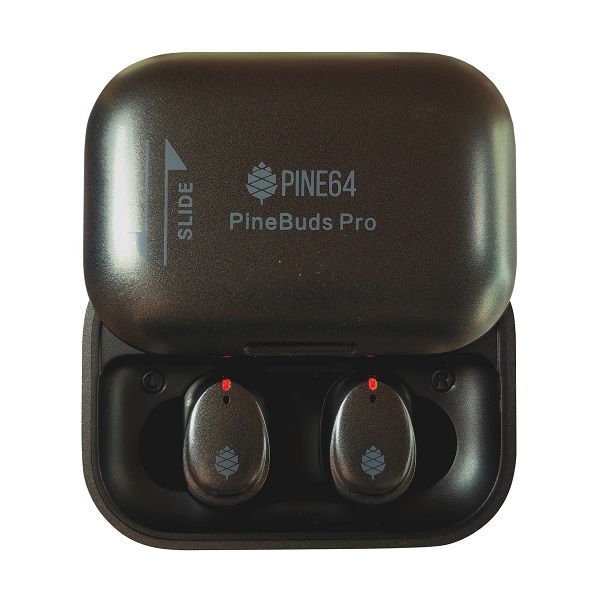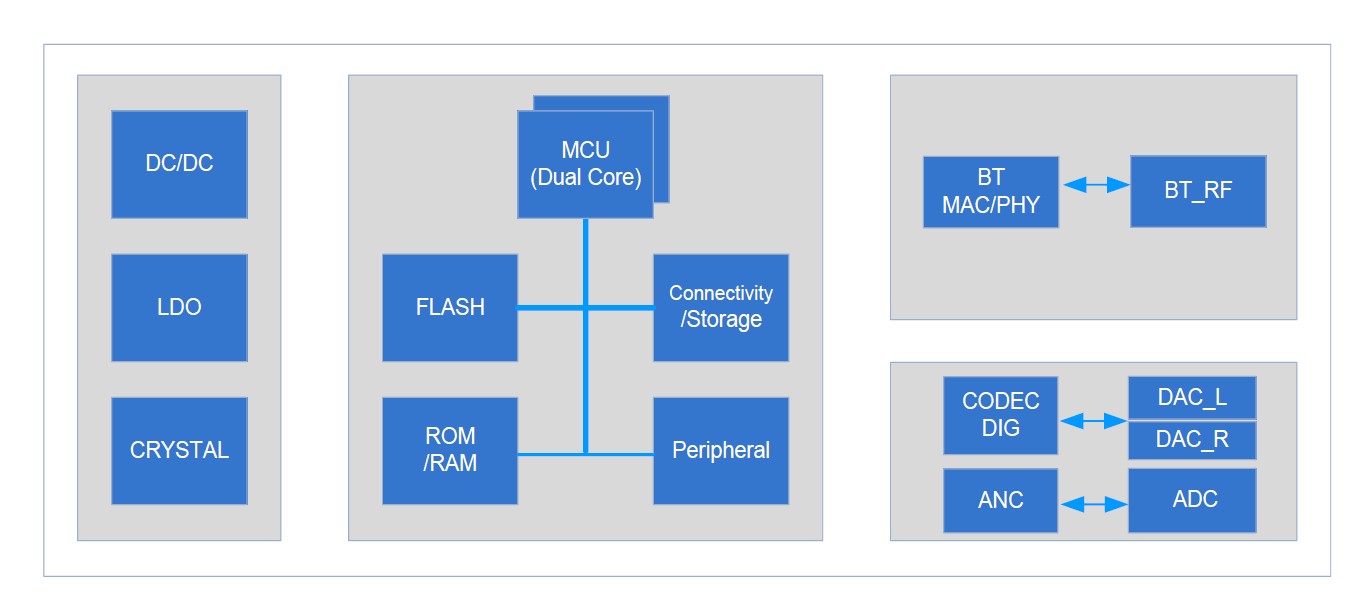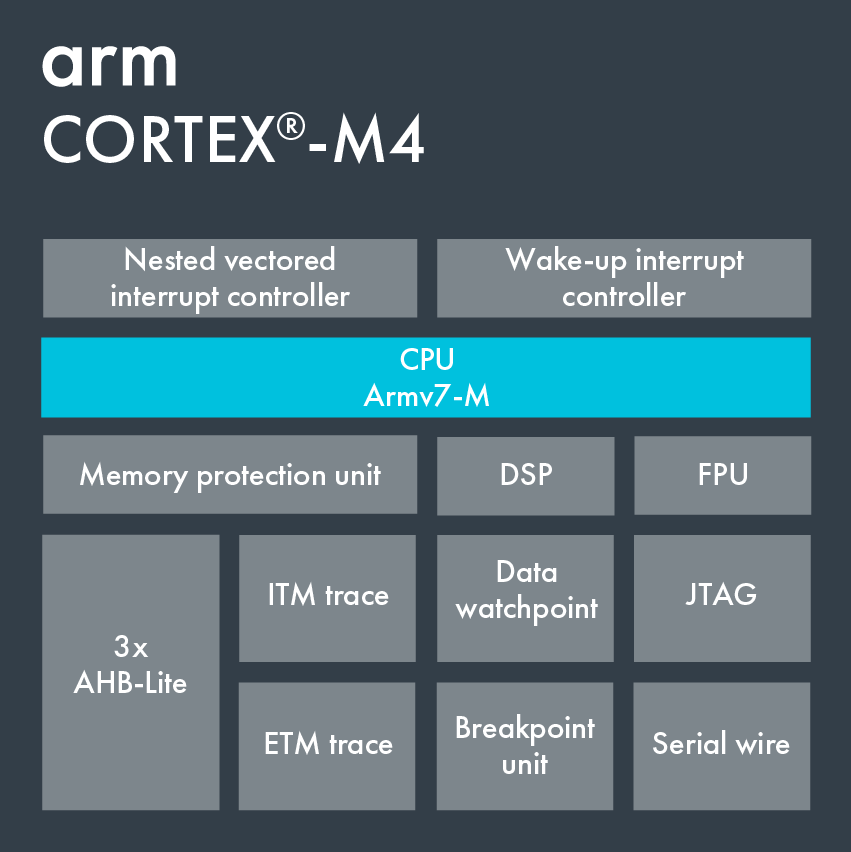Difference between revisions of "PineBuds Pro"
(Added section) |
|||
| (3 intermediate revisions by one other user not shown) | |||
| Line 2: | Line 2: | ||
The '''PineBuds Pro''' are open firmware capable ANC wireless earbuds. Some of the notable features include their light weight, 3 Microphones, ANC (Active Noise Cancellation), ENC (Environment Noise Cancellation) and high fidelity 6mm speaker. It is a fully community-driven side-project which anyone can contribute to, allowing you to keep control of your device even though hardware is proprietary. | The '''PineBuds Pro''' are open firmware capable ANC wireless earbuds. Some of the notable features include their light weight, 3 Microphones, ANC (Active Noise Cancellation), ENC (Environment Noise Cancellation) and high fidelity 6mm speaker. It is a fully community-driven side-project which anyone can contribute to, allowing you to keep control of your device even though hardware is proprietary. | ||
== Software == | == Software == | ||
| Line 51: | Line 23: | ||
== Introduction == | == Introduction == | ||
General information and tips about PineBuds Pro. | General information and tips about PineBuds Pro. | ||
=== Buttons/touch sensors === | === Buttons/touch sensors === | ||
==== Buds ==== | ==== Buds ==== | ||
One capacitive touch sensor is located on the outward facing surface of each bud near the logo. | One capacitive touch sensor is located on the outward facing surface of each bud near the logo. | ||
==== Charging case ==== | ==== Charging case ==== | ||
When the buds are shipped they may have stickers covering their contacts, preventing contact with the charging case. These need to be removed before the buds can be used. | |||
The charging case has a reset button in the center under the lid (between the seats for the two buds,) which is hooked to the ThinkPlus Semi SY8821 integrated circuit and that button resets it from the safety off mode. | |||
=== Cleaning === | === Cleaning === | ||
PineBuds Pro only have IPX4 rating, so they are only splash-proof and cannot withstand immersion in water. Clean the charging case inside and out with a damp microfiber cloth. Inside, be careful near the pogo pins! The cloth easily sticks to them and may tear them. You can use a microfiber cloth at the end of a stick to immerse of the buds, but a cleaning tool made for this can help. When cleaning the buds, carefully remove the tips, place the buds on a damp microfibre cloth and one by one wipe it from all sides. Be careful with the protective mesh. If there is dirt in the mesh, you can carefully clean it with the brush of the previously mentioned tool. Wash the tips with soap and water, but be careful, they easily drip from your hand to drain. After drying them, carefully put them back to the buds. | PineBuds Pro only have IPX4 rating, so they are only splash-proof and cannot withstand immersion in water. Clean the charging case inside and out with a damp microfiber cloth. Inside, be careful near the pogo pins! The cloth easily sticks to them and may tear them. You can use a microfiber cloth at the end of a stick to immerse of the buds, but a cleaning tool made for this can help. When cleaning the buds, carefully remove the tips, place the buds on a damp microfibre cloth and one by one wipe it from all sides. Be careful with the protective mesh. If there is dirt in the mesh, you can carefully clean it with the brush of the previously mentioned tool. Wash the tips with soap and water, but be careful, they easily drip from your hand to drain. After drying them, carefully put them back to the buds. | ||
You need: | |||
* A microfiber cloth | * A microfiber cloth | ||
* A cleaning tool like [https://www.aliexpress.com/item/1005004843772763.html this] or [https://www.aliexpress.com/item/1005004119111965.html this] | * A cleaning tool like [https://www.aliexpress.com/item/1005004843772763.html this] or [https://www.aliexpress.com/item/1005004119111965.html this] | ||
== Community projects == | == Community projects == | ||
| Line 96: | Line 50: | ||
* [[PineBuds Pro/Wireless charging|Wireless charging]], bringing wireless charging to the PineBuds Pro case using vacant contacts | * [[PineBuds Pro/Wireless charging|Wireless charging]], bringing wireless charging to the PineBuds Pro case using vacant contacts | ||
* [[PineBuds Pro/Silicone case|Silicone case]], a transparent silicone case with an improved grip to the case | * [[PineBuds Pro/Silicone case|Silicone case]], a transparent silicone case with an improved grip to the case | ||
* [[PineBuds Pro/Straps|Straps]], to add straps to the PineBuds Pro | |||
== Disassembly / Assembly == | == Disassembly / Assembly == | ||
| Line 101: | Line 56: | ||
Disassembling the charging case: | Disassembling the charging case: | ||
{{Info|1=A video tutorial regarding the disassembly can be watched from | {{Info|1=A video tutorial regarding the disassembly can be watched from ''Linux Lounge'' [https://www.youtube.com/watch?v=xXxRGXWvdVw&t=230s here]}} | ||
# First open the lid and then try to press the case from the front edge with a plectrum or a thin card. There are two clips on each side. Soon the case will snap open. | # First open the lid and then try to press the case from the front edge with a plectrum or a thin card. There are two clips on each side. Soon the case will snap open. | ||
| Line 108: | Line 63: | ||
Assembling the charging case: | Assembling the charging case: | ||
{{Info|1=A video tutorial regarding the assembly can be watched from | {{Info|1=A video tutorial regarding the assembly can be watched from ''Linux Lounge'' [https://www.youtube.com/watch?v=xXxRGXWvdVw&t=230s here] (at the 3:50 minutes timestamp)}} | ||
# Screw the PCB back into the place. | # Screw the PCB back into the place. | ||
| Line 114: | Line 69: | ||
# Close the charging case. | # Close the charging case. | ||
== | == Specifications == | ||
Dimensions: | |||
* Earbud: Unknown | |||
* Charging case: 70 x 50 x 35mm (unconfirmed) | |||
Weight: | |||
* Earbud: 5g | |||
* Charging case: 65g | |||
IP Rating of Earbuds: IPX4 | |||
Dynamic transducer (speaker): 6mm | |||
Microphone: 3 – FeedForward, FeedBack, Talk | |||
System on Chip (in each earbud): BES 2300YP | |||
* CPU: Dual-core 300MHz ARM Cortex-M4F | |||
* ROM: 448KB | |||
* SRAM: 992KB | |||
* BT shared SRAM: 64KB | |||
* Flash: 4MB (Endurance erase cycles: >500) | |||
Communication: | |||
* Bluetooth: Bluetooth 5.2 dual-mode compliant | |||
* USB: USB to dual UARTs at charging case | |||
Battery: | |||
* | * Earbud: Built-in LiPo 3.7V 40mAh | ||
* | * Charging case: Built-in LiPo 3.7V 800mAh | ||
Ports earbud: | |||
* | * 4 pins | ||
Ports charging case: | |||
* 4 pogo pins | |||
* USB type-C port 5V 500mA | |||
== SoC and Memory Specification == | == SoC and Memory Specification == | ||
The PineBuds Pro's buds are based on the [http://www.bestechnic.com/home/product/index/cate_id/6 BES 2300YP]. | The PineBuds Pro's buds are based on the [http://www.bestechnic.com/home/product/index/cate_id/6 BES 2300YP]. | ||
[[File: | [[File:BES2300YP_Block_Diagram.jpg|thumb|right|BES2300YP block diagram]] | ||
[[File:Cortex-M4.png|right|400px]] | [[File:Cortex-M4.png|right|400px]] | ||
CPU Features: | |||
* [https://developer.arm.com/Processors/Cortex-M4 Dual-core ARM Cortex-M4F Processor Processor up to 300MHz CPU] | |||
* CMOS Single-chip Fully-integrated RF, PMU, Audio CODEC and Cortex-M4F CPU | |||
Memory Features: | |||
* 4MB Serial Flash On-chip for Custom Program | |||
* Internal ROM 448KB for critical constants and code | |||
* Internal SRAM 992KB for critical data and code | |||
BT Features: | |||
* Bluetooth 5.2 dual-mode compliant | |||
* Profiles: A2DP, AVRCP, HFP | |||
* Audio Codecs: SBC, AAC | |||
Audio Features: | |||
* Support BES Intelligent Bluetooth Retransmission (IBRT) | |||
* Support FF/Hybrid ANC | |||
* Dual MICs noise reduction | |||
* Echo Cancellation | |||
* Support low power voice activity detection | |||
* Multi-band EQ and Bass enhancement | |||
* Support Active Crossover | |||
* Support TWS | |||
* HiFi Stereo Audio DAC: 120dB SNR, 110dB DNR | |||
* HiFi Stereo Audio ADC: 100dB SNR | |||
* Sample rates from 8 kHz to 384 kHz | |||
* Support dual/single Mic noise suppression | |||
** -45dB attenuation nominal 50-200Hz | |||
** -55dB max attenuation @150Hz | |||
* Support ambient awareness | |||
* Support talk through | |||
* 24-bit audio processing | |||
PMU Features | |||
* 3.1V-5.5V Input for VBAT | |||
* Internal LPO for low power mode. | |||
* DCXO with internal oscillator circuit | |||
* Internal temperature sensor | |||
== Information, Schematics and Certifications == | == Information, Schematics and Certifications == | ||
Latest revision as of 20:24, 3 November 2024
The PineBuds Pro are open firmware capable ANC wireless earbuds. Some of the notable features include their light weight, 3 Microphones, ANC (Active Noise Cancellation), ENC (Environment Noise Cancellation) and high fidelity 6mm speaker. It is a fully community-driven side-project which anyone can contribute to, allowing you to keep control of your device even though hardware is proprietary.
Software
Firmwares
Firmware images
Flash back factory default firmware using Windows based utility:
- PineBuds Pro Windows based programmer utility user manual
- PineBuds Pro Windows based programmer utility
- PineBuds Pro factory default firmware build
- PineBuds Pro factory default OTA build
SDK release
Introduction
General information and tips about PineBuds Pro.
Buttons/touch sensors
Buds
One capacitive touch sensor is located on the outward facing surface of each bud near the logo.
Charging case
When the buds are shipped they may have stickers covering their contacts, preventing contact with the charging case. These need to be removed before the buds can be used.
The charging case has a reset button in the center under the lid (between the seats for the two buds,) which is hooked to the ThinkPlus Semi SY8821 integrated circuit and that button resets it from the safety off mode.
Cleaning
PineBuds Pro only have IPX4 rating, so they are only splash-proof and cannot withstand immersion in water. Clean the charging case inside and out with a damp microfiber cloth. Inside, be careful near the pogo pins! The cloth easily sticks to them and may tear them. You can use a microfiber cloth at the end of a stick to immerse of the buds, but a cleaning tool made for this can help. When cleaning the buds, carefully remove the tips, place the buds on a damp microfibre cloth and one by one wipe it from all sides. Be careful with the protective mesh. If there is dirt in the mesh, you can carefully clean it with the brush of the previously mentioned tool. Wash the tips with soap and water, but be careful, they easily drip from your hand to drain. After drying them, carefully put them back to the buds.
You need:
Community projects
The following community projects are currently being worked on:
- Wireless charging, bringing wireless charging to the PineBuds Pro case using vacant contacts
- Silicone case, a transparent silicone case with an improved grip to the case
- Straps, to add straps to the PineBuds Pro
Disassembly / Assembly
Disassembling the charging case:
- First open the lid and then try to press the case from the front edge with a plectrum or a thin card. There are two clips on each side. Soon the case will snap open.
- Carefully unscrew and remove the PCB from the case.
Assembling the charging case:
- Screw the PCB back into the place.
- There is plenty of space, glue the coil to the bottom of the case.
- Close the charging case.
Specifications
Dimensions:
- Earbud: Unknown
- Charging case: 70 x 50 x 35mm (unconfirmed)
Weight:
- Earbud: 5g
- Charging case: 65g
IP Rating of Earbuds: IPX4
Dynamic transducer (speaker): 6mm
Microphone: 3 – FeedForward, FeedBack, Talk
System on Chip (in each earbud): BES 2300YP
- CPU: Dual-core 300MHz ARM Cortex-M4F
- ROM: 448KB
- SRAM: 992KB
- BT shared SRAM: 64KB
- Flash: 4MB (Endurance erase cycles: >500)
Communication:
- Bluetooth: Bluetooth 5.2 dual-mode compliant
- USB: USB to dual UARTs at charging case
Battery:
- Earbud: Built-in LiPo 3.7V 40mAh
- Charging case: Built-in LiPo 3.7V 800mAh
Ports earbud:
- 4 pins
Ports charging case:
- 4 pogo pins
- USB type-C port 5V 500mA
SoC and Memory Specification
The PineBuds Pro's buds are based on the BES 2300YP.
CPU Features:
- Dual-core ARM Cortex-M4F Processor Processor up to 300MHz CPU
- CMOS Single-chip Fully-integrated RF, PMU, Audio CODEC and Cortex-M4F CPU
Memory Features:
- 4MB Serial Flash On-chip for Custom Program
- Internal ROM 448KB for critical constants and code
- Internal SRAM 992KB for critical data and code
BT Features:
- Bluetooth 5.2 dual-mode compliant
- Profiles: A2DP, AVRCP, HFP
- Audio Codecs: SBC, AAC
Audio Features:
- Support BES Intelligent Bluetooth Retransmission (IBRT)
- Support FF/Hybrid ANC
- Dual MICs noise reduction
- Echo Cancellation
- Support low power voice activity detection
- Multi-band EQ and Bass enhancement
- Support Active Crossover
- Support TWS
- HiFi Stereo Audio DAC: 120dB SNR, 110dB DNR
- HiFi Stereo Audio ADC: 100dB SNR
- Sample rates from 8 kHz to 384 kHz
- Support dual/single Mic noise suppression
- -45dB attenuation nominal 50-200Hz
- -55dB max attenuation @150Hz
- Support ambient awareness
- Support talk through
- 24-bit audio processing
PMU Features
- 3.1V-5.5V Input for VBAT
- Internal LPO for low power mode.
- DCXO with internal oscillator circuit
- Internal temperature sensor
Information, Schematics and Certifications
The charging case's input power: DC 5V @ 0.5A USB Type-C
Documents:
Schematics:
Certifications:
- PineBuds Pro CE EMC Certificate
- PineBuds Pro CE RED Certificate
- PineBuds Pro FCC Certificate
- PineBuds Pro ROHS Report
Datasheets for Components and Peripherals
BES 2300YP SoC information:
Charging case:
- ThinkPlus Semi SY8821 Datasheet in Chinese
- WCH Tech CH342DS USB to Dual Serial ports chip Datasheet
- COPO CP2021 2.5W Qi Wire Power Receiver Datasheet (Unpopulated)
EarBuds:


